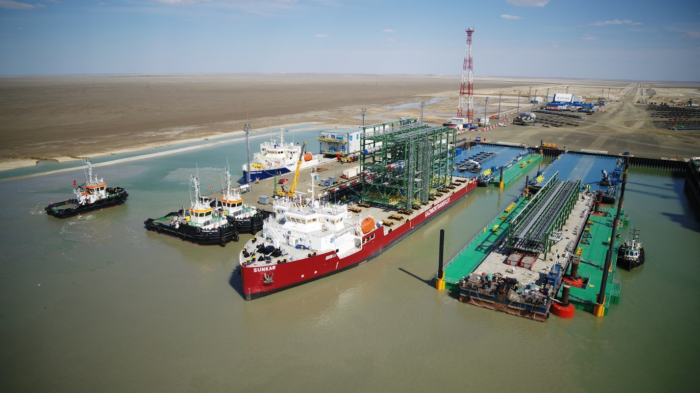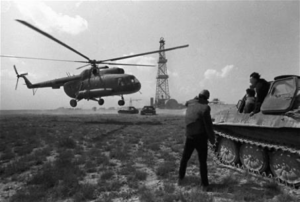Kazakhstan marked an important anniversary on April 6. The American oil company Chevron entered the former Soviet country and signed a 40-year contract to develop the Tengiz oil field, located in western Kazakhstan 30 years ago.

Photo credit: Tengizchevroil.
The Tengiz oil field was discovered by Soviet geologists in 1979. An article in The Washington Post described the field as located on a “remote, windblown steppe on the northeast shore of the Caspian.” Soviet engineers named the field Tengiz, the Kazakh word for “sea.”
While credit for discovering the rich oil field goes to the Soviets, the ultimate development of its tremendous resources was beyond their capability. In the same year they located Tengiz, the Soviets began a decade-long military operation in Afghanistan. Even before military involvement in Afghanistan, the economic, social, and political future of the Soviet Union was already extremely fragile. Dealing with pressures and uncertainties, and a lack of technology, the Soviets were not able to undertake the complex task of developing the Tengiz field. Accessing the oil was a daunting task. According to the Washington Post, the Tengiz reserves were “as much as three miles below a salt dome that itself was 900 yards thick,” and “Soviet engineers spent more than $1 billion drilling dozens of wells before concluding that foreign technology was needed.”

Tengiz oil field, located on the west part of Kazakhstan, was discovered in 1979. Photo credit: Tengizchevroil.
Ultimately, it would be Chevron, then the fifth-largest private oil company in the world, which would provide the foreign technology and money for the Tengiz oil exploration. The American company signed a contract with the Kazakh government that quickly earned the title The Deal of the Century. Although at the time of its signing, all the glory for landing the deal went to then President Nursultan Nazarbayev, behind the scenes the decision to “let” the Americans enter one of the most lucrative oil fields in the former Soviet Union was actually made by Soviet and American leadership.
Many sources suggest that the initial idea of creating a joint venture with Chevron originated with Mikhail Gorbachev, the first and last President of the USSR. The final negotiations with Chevron were on the agenda of his historic talks with President George Bush in 1991. These same talks were the occasion for signing a landmark agreement on cutting both countries’ nuclear arsenals, a move which effectively “ended” the Cold War.

CPC pipeline was put into operation for transportation of Tengiz field to oil stations of the Black Sea port in 2001.
In a quotation from June 3, 1990, AP News cited Gorbachev as referencing discussions with American companies “While we and the president were working and our ministers were also discussing things, there were important contact discussions with various Americans companies and some important decisions were made.” One of those companies under discussion was Chevron Corp, the San-Francisco based oil firm that had engaged with Moscow about the possibilities for exploration of the Tengiz field long before the fall of the Soviet Union.
According to archival sources, Richard Matzke, a vice president of Chevron during those years, first heard about Tengiz in the late 1980s. Apparently, he was the one who pressed the case for Chevron to enter the Soviet market and persisted in negotiating a contract that gave Chevron a 50 percent interest in one of the most precious post-Soviet energy assets. There is information that the night before the deal was signed, George Bush, Gorbachev, Matzke and the Soviets’ top energy officials stayed up until 3 a.m. shouting at each other over the details of the deal.

Second Generation Plant.
From the very beginning, the deal with Chevron was a political affair that gave leverage to both Gorbachev and Bush in their nuclear negotiations. According to popular opinion, Gorbachev could cancel the deal with Chevron if his talks with Bush led to an unfavorable outcome. On the other side, Bush always stressed that the Soviets did not have adequate drilling technology or the appropriate skills to develop such an enormous oil field that could bring huge economic benefits to both countries. The political character of the joint venture between the American oil giant and the government of Kazakhstan prompted serious complaints from the Soviets who were displeased about Chevron being granted substantial exploration rights and a much higher share of the profits.
Although exclusive rights for the Tengiz oil exploration were given to Chevron by Gorbachev in 1990, the project slowed down and even came to the brink of failure due to exhausting bureaucratic problems between Chevron and the Soviet oil ministry. In the end, it took until April of 1993 for Chevron and the government of Kazakhstan to complete the deal on developing the Tengiz field. By the time the Americans began considering Tengiz, the political leaders of the USSR were preoccupied with the catastrophic breakup of the Soviet Union and had lost their long-term vision for many other issues, including developing Tengiz. According to Matzke, “the project was caught up in countervailing political forces in a country deep in the throes of fundamental change.”

Photo credit: Tengizchevroil.
The disintegration of the Soviet Union eventually led to establishing Kazakhstan’s independence. Part of becoming a sovereign country included Kazakhstan retaking the rights to all of its mineral resources. These developments accelerated Chevron’s chances in finally getting the contract for the largest newly discovered oil field in the post-Soviet area.
This was the moment when an important figure met with a significant opportunity. Nazarbayev seized the moment and became the key player in the negotiations with the Americans. In his well-known book “Nazarbayev and the Making of Kazakhstan” biographer Jonathan Aitken writes “after meetings with President Bush, Nazarbayev made a commitment to sign the Nuclear Non-Proliferation Treaty, The Strategic Arms Reduction Treaty, and to remove 120 Soviet SS18 nuclear missiles” from Kazakhstan’s territory. “In return”, continues Aitken, “Nazarbayev left Washington with an aid, trade and energy cooperation package; a $10 billion investment in Kazakhstan’s oil fields from the American company Chevron; and a promise that in accordance with the UN charter, the United States would take all possible measures if Kazakhstan came under threat from aggression.”
President Kassym-Jomart Tokayev said the 30th anniversary of Tengizchevroil is a significant event for the oil and gas industry during the ceremony dedicated to the 30th anniversary of Tengizchevroil (TCO) on April 4.
Chevron is the first foreign company to establish a joint venture with Kazakhstan. “Today TCO as a leading international company successfully contributes to the country’s overall economic progress. TCO produces one third of the country’s total oil output. Over the 30 years, the company has invested $70 billion, delivered more than $160 billion in direct financial payments to the country. Equally important is the fact that 70 percent of the company’s procurement represents local, Kazakh content. More than 95 percent of TCO’s workforce are our citizens,” the President said.
Thirty years later the ink on the deal to develop the Tengiz oil field is long dried but the oil is still flowing steadily thanks to the continuing partnership of Chevron and the government of Kazakhstan. Decades into Kazakhstan’s independence, the oil sector remains the most dominant factor in the country’s stable political and economic development. For both Chevron and Kazakhstan The Deal of the Century turned out to be a pretty good deal indeed.
The author is an analyst with a Master’s Degree in Economics from Georgetown University in Washington, DC, with more than 20 years of experience working for the Kazakh government. She focuses on macroeconomics, commodity, financial markets, and economic and social policies in Kazakhstan and globally.


